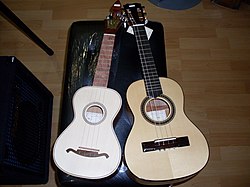Cavaquinho

Portuguese & Brazilian cavaquinhos
|
|
| String instrument | |
|---|---|
| Other names | Machete, braguinha, manchete, cavaco |
| Classification | String instrument |
| Hornbostel–Sachs classification |
(Composite chordophone) |
| Developed | Portugal |
| Related instruments | |
| Ukulele, Viola Braguesa | |
The cavaquinho (pronounced [kɐvɐˈkiɲu] in Portuguese) is a small string instrument of the European guitar family with four wire or gut strings. A cavaquinho player is called a cavaquista.
The most common tuning is D–G–B–D (from lower to higher pitches); other tunings include D–A–B–E (Portuguese ancient tuning, made popular by Júlio Pereira) and G–G–B–D and A–A–C♯–E. Guitarists often use D–G–B–E tuning to emulate the highest four strings of the guitar (also the same tuning as the baritone ukulele). The G–C–E–A tuning is sometimes used to emulate the soprano/tenor ukulele, an instrument developed from the braguinha and rajão, brought to Hawaii by Portuguese immigrants, from Madeira Island, in the late 19th century.
The origins of this Portuguese instrument are elusive. Gonçalo Sampaio, who explains the survival of Minho region’s archaic and Hellenistic modes by possible Greek influences on the ancient Gallaeci of the region, stresses the link between this instrument and historical Hellenistic tetrachords. The author holds that the cavaquinho and the guitar may have been brought to Braga by the Biscayans.
There are different kinds of cavaquinho. The minhoto cavaquinho, associated with the Minho region in Portugal, has the neck on the same level as the body, and the sound hole is usually in the raia format (raia is Portuguese for batoidea); it is more akin to the viola braguesa.
...
Wikipedia
